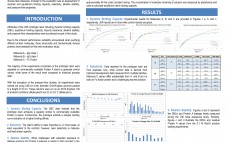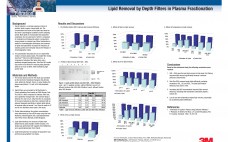Endotoxin or lipopolysaccharides (LPS) are highly toxic components of the cell wall of Gram-negative bacteria and are often present in significant amounts in bacterial cell culture expression systems such as E. coli. A number of methods have been adopted for the removal of endotoxin based on adsorption, in particular ion-exchange chromatography. Although downstream processing can significantly reduce endotoxin levels in the product, efficient and cost-effective removal of residual endotoxin from biopharmaceutical preparations remains a challenge. This technical poster addresses the…
Downstream Processing
Evaluation of a Novel Polymer Based Protein A Resin for the Capture of Immunoglobulins and Fc-Fusion Proteins
In the biopharmaceutical industry ever increasing monoclonal antibody titers in cell culture have necessitated discovery of more efficient Protein A capture operations, realized in terms of higher binding capacity, faster throughput, increased resin lifetime, and decreased cost of goods. Recent changes in the Protein A intellectual property landscape have invited new competitors to enter this market. Given the increased availability of new Protein A technology, Biogen Idec has evaluated a prototype resin being developed by JSR Life Sciences known as…
New Core Bead Chromatography Medium Enables Group Separation and High Productivity Purification of Large Molecules
When large biomolecules such as IgM or influenza virus are purified, group separation with gel filtration is the most commonly used technique. Advantages of using gel filtration include the high purity and the high recoveries that can be achieved, while a drawback is the relatively low productivity. Captoâ„¢ Core 700 is a chromatography medium (resin) from GE Healthcare Life Sciences designed with core bead technology. The core bead technology enables double functionality for Capto Core 700 – size exclusion and…
AbSolute® High Cap by Novasep: Revolutionary Protein A Media
Novasep has developed AbSolute® High Cap, an optimized silica-based protein A media for the capture of monoclonal and polyclonal antibodies. This protein A media is adapted to all fermentation volumes while offering the highest dynamic and static binding capacities (DBC10% ≥ 60 mg/mL, SBC ≥ 95 mg/mL) and, as a result, high productivities at all velocities. By decreasing the amount of resin required to downstream a feed (30-50% less), AbSolute® High Cap enhances the robustness of the protein A capture…
When downstream process is able to withstand upstream changes! An example of clarification sequence optimization in viral vaccine production
While improving cell growth and viral productivity in USP, DSP may become the production bottleneck if not able to withstand changes. Such a case appears when optimizing cell culture media during the development of a viral vaccine candidate. Thirty percent expression increased was balanced by twenty percent yield loss and filters clogging during the clarification step. As a consequence, clarification sequence was not scalable anymore for the further manufacturing. The poster describes sanofi pasteur approach to overcome this issue and…
Characterization of a Novel High-Capacity Weak Cation Exchange Resin
Ion exchange resins with increased selectivity and binding capacity are now in demand and it is imperative for chromatographers to have such resins in their repertoire. The Toyopearl GigaCap® family of resins was created to meet these demands. This poster will focus on Toyopearl GigaCap CM-650M resin as a novel high-capacity weak cation exchange resin for the purification of biomolecules. A polymethacrylic base bead, Toyopearl HW-65, was chemically modified with carboxymethyl groups in the 1000Ã… pores of the bead which…
Evaluation of Ultra Performance Size Exclusion Chromatography for the Analysis of Proteins and Higher Order Aggregates
Complete characterization and analysis of biopharmaceuticals includes size exclusion chromatography (SEC) to measure protein aggregates and other size variants. Current silica-based HPLC-SEC methods can be time-consuming and unreliable. New advances in packing materials and instrumentation have allowed faster and more reproducible separations to be achieved. Improvements in resolution, sensitivity and throughput will be demonstrated for sub-2 μm SEC packing materials as compared to traditional silica-based columns. The effect of pore size and particle size for the analysis of aggregates and…
Lipid Removal by Depth Filters in Plasma Fractionation
We herein describe a 3M Purification Inc. depth filter media – Zeta PlusTM DELI that exhibits selective adsorptive properties for plasma lipids. Lipids plug chromatographic columns and filters during plasma fractionation steps and cause solution instability for the final product. Several parameters which could affect the lipid removal efficiency on Zeta Plus DELI have been investigated: prefiltration, contact time, ionic strength, pH, and temperature. The maximum percentage of total lipids eliminated, in optimal operating conditions, was 68%. This method has…
Protein A Cellulose, a new mAb purification platform
Protein A chromatography is widely used as capture step in monoclonal antibody purification processes. Many types of chromatographic media are commercially available for this application however mainly Agarose and Porous glass based products are considered as standard mAb purification platforms due to high dBC and high operational flow rates. In fact process optimization of Protein A step is mainly aimed to have higher capacity and lower elution volumes in shorter process time. In this context Kaneka has been investigating highly…
Salt-tolerant cation exchanger for direct capture of proteins
Ion-exchange chromatography is widely used for the purification of biotherapeutic proteins. Usually, cation exchangers are applied in the primary capture step of proteins with alkaline pI. Conventional ion-exchange chromatography has the advantage of high-binding capacity, but it requires low salt conditions for protein binding and consequently adjustment of conductivity of clarified culture supernatant. An alternative method to maintain some binding capacity at higher conductivity levels is working at low pH condi¬tions notwithstanding that some proteins are sensitive to acid treatment.…










